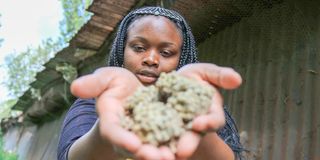Farmers’ pain as low quality feeds find way into market

Maureen Wanyaga, a rabbit keeper in Gathaithi village in Tetu, Nyeri County, displays mold-infested rabbit pellets. She is among farmers who have paid the price for using poorly prepared commercial feeds.
What you need to know:
- Some have lost their livestock while others have registered decreased production after feeding their animals commercially prepared feeds that laboratory analysis indicates could be from unscrupulous manufacturers flooding the market with substandard products
- Death, low production and diseases are some of the consequences farmers are grappling with after feeding their animals substandard products.
- Death, low production and diseases are some of the consequences farmers are grappling with after feeding their animals substandard products.
- Animals get exposed to aflatoxins through the food they eat. Animals feeds that are most likely to be contaminated are maize, cottonseed, copra and peanuts
On an ideal livestock farm, feeds account for between 60 and 70 percent of production costs, making it the most important ingredient in producing meat, eggs and milk, among other animal products.
Therefore, if a farmer does not get it right with feeds, they should be assured of harvesting losses.
This is a fact many farmers know, which is why a majority go for commercial feed rations.
But feeds, which are readily accessible at agrovet shops, are turning out to be farmers’ worst nightmare as some unscrupulous manufacturers produce low-quality products.
Death, low production and diseases are some of the consequences farmers are grappling with after feeding their animals substandard products.
Maureen Wanyaga, a rabbit keeper in Gathaithi village in Tetu, Nyeri County, is among farmers who have paid the price of using poorly prepared commercial feeds.
Contaminated product
Since September, she has lost at least 250 rabbits out of the 1,300 she kept after giving them contaminated pellets.
“The problem began after I bought bags of pellets from a leading feeds manufacturer,” recounts the farmer who started the business in 2017.
“The rabbits began dying one by one, some a few hours after eating the contaminated product.”
Maureen informed the manufacturer of the losses and one of their officers based in Nyeri asked her to stop offering the animals the feed.
They later sent representatives to assess the situation and craft a way forward as she pushed for compensation. But these officials blamed the cold weather on the problem and did not follow up later.”
She took a sample of the feeds for testing at a private laboratory, which surprisingly gave them a clean bill of health”, though Maureen suspected foul play.
Tested for aflatoxin
“Their analysis indicated the feeds had been tested for aflatoxin and contained 8.02 parts per billion (ppb) per kilo, an indication that they were of good quality. The recommended aflatoxin levels in animal feed is usually10ppb per kilogramme,” she offers.
However, Maureen was not convinced as her rabbits continued to die. Her quest for justice made her encounter Futa Mahendra Action Network, a lobby group in Nyeri, through which she was able to get samples of the feeds tested again by the Kenya Bureau of Standards (Kebs).

Joseph Muchiri, who has lost close to 100 rabbits on his farm in Nyeri. Animals get exposed to aflatoxins through the food they eat.
Caroline Outa-Ogweno, the Kebs Mt Kenya region manager, in a report, says they found the feeds were highly contaminated with aflatoxin.
The batch that was due for expiring in October next year fell short of the Kebs rabbit feed supplement specifications.
"The test reports showed the feeds contained aflatoxin level of 24.40ppb per kilogramme of the pellets," she says in her report.
Tests on other samples of the pellets at the Kenya Veterinary Investigation Laboratory (KVIL) showed one bag contained 17 times the number of aflatoxin recommended while the second one had 27.04ppbs.
Low quality feeds
"We have found the feeds contained high levels of aflatoxins, with the highest having up to 176.24 ppb per kilo of pellets," says Mburu Kimani in a report for the institution's director of veterinary services.
James Mugo, the chairman of Futa Mahendra Action Network, said so many farmers have been affected by the low-quality feeds.
“It is not only rabbits, the problem cuts across the livestock sector, from dairy to chickens, fish and even dogs are not spared. But instead of the companies addressing the issue and compensating farmers, they are unmoved,” he says, asking the government to take action on rogue manufacturers.
Stephen Wakonyo, a rabbit farmer in Kieni, has lost close to 100 rabbits out of his 3,000 rabbits due to bad feeds.
“I rear over 12 breeds of rabbits and I keep records to monitor their progress.I have recorded a death every single day since the arrival of the pellets. A veterinary officer pointed out the feeds had high levels of aflatoxin.”
In a similar situation is pig farmer James Mutua and poultry keeper Martin Gimole, whose livestock have had stunted growth and low production due to using feeds with low nutrients.
Cuts across the livestock sector
Seeds of Gold efforts to get a comment from one of the firms that sold suspect feeds were futile. We wanted to know what they are doing to correct the situation and if they will compensate farmers.
Dr Joseph Mugachia, a veterinary surgeon, says symptoms of animals poisoned after eating aflatoxin-contaminated feeds include loss of appetite, dullness, abdominal pain and bloody diarrhoea.
Others lose weight slowly, have abdominal and leg swelling, low blood levels and the mucous membranes turn yellow.
“These signs represent the three types of poisoning called acute and chronic poisoning. Another form is peracute poisoning, where the animal dies suddenly due to the consumption of a high dose of poison in the food.

Farmer Maureen Wanyaga on her rabbit farm in Nyeri. Since September, she has lost at least 250 rabbits out of the 1,300 that she kept, after giving them contaminated pellets.
Post-mortem examination on such animals shows a lot of bleeding in the intestines and kidneys,” notes Mugachia, adding the problem has become rampant, affecting all animals.
He notes that it is hard for farmers to tell contaminated feed from one which is safe during purchase.
“It is the responsibility of the manufacturer and the seller of the feeds to ensure the product is of high quality. Looking out for molds is a late sign that the feeds are contaminated,” he says.
Exposed to aflatoxins
According to him, legally, farmers have to prove that a manufacturing company sold contaminated feeds.
“Farmers should ask for compensation or proceed to court if the company fails to settle in an out-of-court agreement.”
Kenya Veterinary Association chairman Samuel Kahariri said maize is the dominant ingredient in animal feed formulation, thus its contamination poses a great danger as it compromises the health of both animals and human beings.
"Since aflatoxins cannot be detected by sight or smell in contaminated feed or food and cannot be eliminated by boiling, cooking or processing into compound feeds, it is imperative that contaminated maize should not be sold to animal feed manufacturers," he says.
All animals are affected by aflatoxins, he says, noting that rabbits, ducks and pigs are highly susceptible; dogs, calves, turkeys and sheep are moderately susceptible while chicken and cattle are relatively resistant.
He added that fish vary from highly susceptible to resistant.
"Animals get exposed to aflatoxins through the food they eat. Animals feeds that are most likely to be contaminated are maize, cottonseed, copra and peanuts," he says.
****
Storage
1. Feeds should not be placed on the floor or against a wall, where they can easily get molds.
2. They should be stored on a wooden pallet or raised surface. Dry wood is preferred as it does not generate moisture.
3. Raw materials used in the making of animal feeds such as grains, cottonseed cake, and sunflower cake should be well-dried and properly stored.
4. They should always be dried to a moisture content of 22-25 percent.
- Dr Mugachia.





